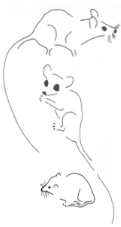- The work aimed at a better understanding of how density regulation operates and how it modifies the impacts of habitat fragmentation and climate change on species and community persistence.
- The approach built upon mechanistic simulation models of single species and communities of species and was twofold: First, hypothetical species were investigated to analyse basic principles and to derive general hypotheses; second, real species were investigated. In a collaborative project with partners from Brazil we used hierarchical bayesaian modelling approaches to analyze assembly of a small mammal community living in the remnant forest patches of the Mata Atlântica (Brazil). One of the major questions in this project is to assess the relative importance of neutral and niche-based processes. This study is part of the (Mata Atlântica Project).
current research
Ecological theory suggests that the temporal and spatial distribution of plant diversity is driven by community assembly processes, evolution and biogeographical events. Plant diversity is in addition strongly linked to ecosystem functioning and feedbacks with soil processes. The study of species and functional diversity patterns combined with null model testing has become increasingly common to infer ecological processes from observed distributions of diversity. However, in these studies plant-soil feedbacks are frequently ignored and we lack understanding of their impacts on assembly processes and their cascading effects on ecosystem functioning.
In highly constrained environments such as mountainous regions on-going climate change and land use change strongly influence these processes and resulting biodiversity patterns. In my research I focus on the functional and phylogenetic diversity of alpine flora with the aim to better understand the mechanisms determining diversity, resilience and ecosystem functions across multiple scales. This work is part of the TEEMBIO project and is in cooperation with Wilfried Thuiller and Sébastien Lavergne.

Functional diversity and ecosystem stability
What is the effect of plant functional diversity on ecosystem stability and functioning? Can we demonstrate relationships of plant functional trait composition and proxies of photosynthetic activity at large spatial scales? How can we study the resilience of plant communities in the face of environmental change with process-based simulation models of vegetation structure, i.e. what are the important components to measure? Which comonents of assembly structure influence resilience?Plant-soil feedback and ecosystem functioning
How will plant-soil feedbacks (PSF) influence the impacts of environmental change on plant community assembly, biodiversity patterns and ecosystem functioning? What is the relative importance of PSF through fungal vs. bacteria dominated (and thus slow vs. fast) nutrient cycles, soil mutualists vs. soil antagonists? How do PSF affect plant-plant biotic interactions along environmental gradients? How important is it to account for PSF when studying effects of land-use change and climate-driven species' range shifts? What are the cascading short-term and long-term effects of land-use change and climate change on plant assembly processes, diversity and ecosystem functioning?Community assembly
Local communities assemble out of a pool of species available in a region. But are abiotic or biotic processes the main drivers of this community assembly? How do these drivers depend on species' characteristics, fitness and niches? And which methods are available and which need to be refined or newly developed to test related hypotheses?Trait and niche evolution in space and time
How does the interplay between ecological and evolutionary processes drive the spatial and temporal distribution of species? Can phylogenetic signal and phylogenetic niche conservatism be used to identify the signatures that these processes leave in the distribution of species characteristics in the phylogenies? How do phylogenetic signal and phylogenetic niche conservatism differ?phd research
My PhD research focussed on density regulation processes. Intra- and interspecific density regulation, as it results from competitive interactions between con- and heterospecifics, affects population and community dynamics and thus can interfere with both single species survival and multi-species coexistence.
| Welcome |
| Research |
| Publications |
| CV |
| Links |